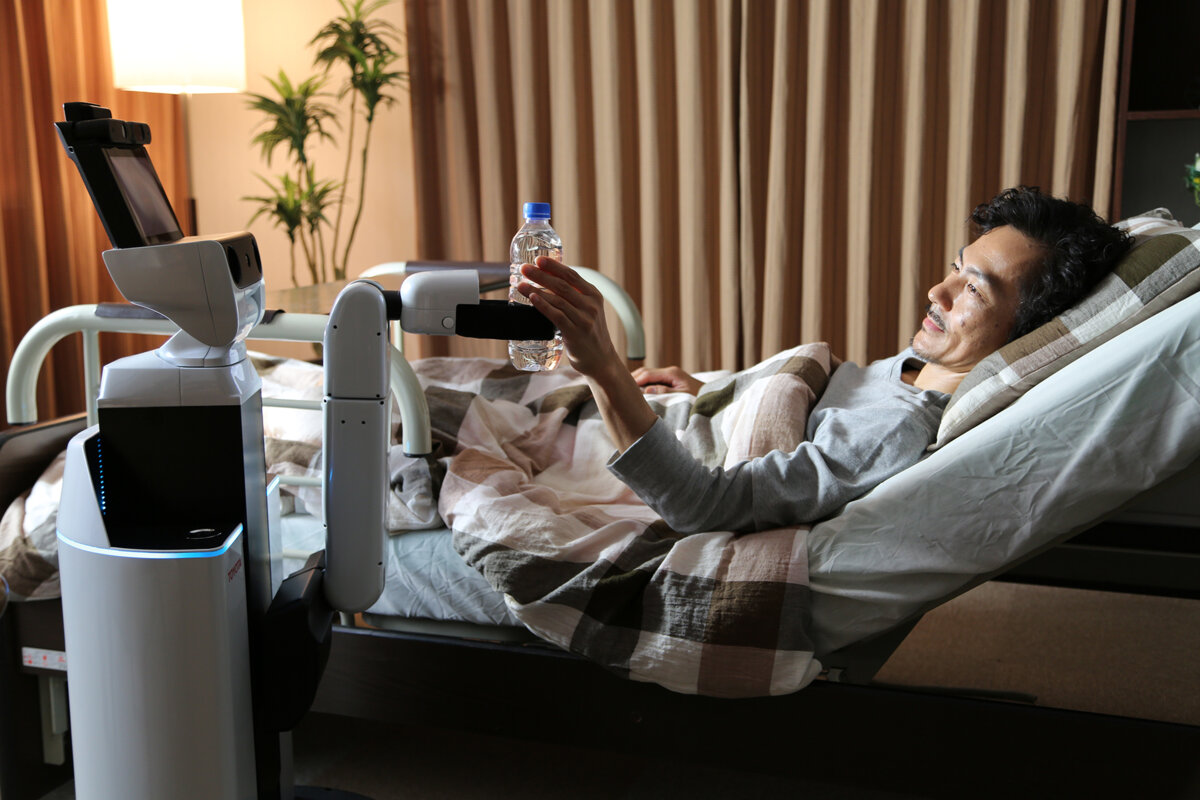
Agrandissement : Illustration 1

Stylized as a culture whose machine-savvy roots date back as early as the 17th century (when, for instance, tea-serving automata were developed) and whose post-WWII icon was an android named “Astro Boy,” Japan unsurprisingly promoted robots as the secret stars of the Tokyo Olympics 2020 – from care robots providing assistance to spectators in wheelchairs by carrying food and other goods, guiding people to their seats, and providing event information, to so-called Field Support Robots assisting athletes and guiding staff. How do you assess this marketing effort?
Perhaps the Field Support Robots will appear at the Tokyo Olympics in the next year, but they might just be an exceptional showcase example. I think it is a symptomatic marketing effort – symptomatic of a little effective push for ‘robotization.’ Personally, I have not seen any humanoid-type robots in social reality, other than in publicity images and commercials. Just to give an example from the care sector: Only 8% of home nursing in Japan had introduced lifting machinery in 2015. Although the government has provided subsidies to spread nursing robots, a recent survey reveals that in 2017 only 6 of 30 executives had introduced nursing robots, and half of their “robots” were sensors detecting seniors’ actions. The reason provided by 56% of nursing homes for not introducing them was that the “robots” were too “expensive,” 8% said that they were too “difficult to use,” while 8% said that “nursing is the work of humans.”
When the Tokyo Olympics 2020 were postponed due to the pandemic – and the government declared a ‘state of emergency over coronavirus’ shortly thereafter – the media narrative of ‘robots as secret stars’ changed. Suddenly, stories proliferated that depicted Japan as a country that is less ‘high-tech’ and more ‘low-tech’ – and therefore perhaps not ready to deal with the challenges of the ‘corona crisis.’ What does it bring to light about the mythical image of Japan as ‘the land of robots’?
The government survey says that only 5% of public schools in Japan were able to utilize online unilateral education in April 2020 during the school closure. According to that survey, 13.9% of Japanese companies had introduced teleworking by 2017. The rate of teleworking jumped to 27.9% in April 2020. This means that it still remains a minority. Many parents and workers in Japan have realized that their reality is less robotized and less technology-savvy than the image of ‘the land of robots’ would suggest.
In Asia, mass media in countries as different as India, China, and Japan co-produced the meme of ‘robots as heroes in the war on corona.’ Here, ground robots come to the fore as immune and contagion-free workers who deliver medicine, serve meals, take temperatures, disinfect rooms, handle communications. Meanwhile, ‘aerial robots’ produced by the Japanese company Terra Drone are safely transporting medical and other supplies from disease control centers to hospitals without exposing humans to infection. Of course, with the web becoming the main site of social interaction, an increasing number of ‘disembodied robots’ have also come to the fore – in the form of self-learning algorithms. How do you see the meme of ‘robots as heroes in the war on corona’ connected to the mythical image of Japan as ‘the land of robots’?
So far, I have not seen images or heard of stories in Japan that promote the idea of ‘robots as heroes in the war on corona’. Instead, care workers are being praised in Japan – just like in other countries.
In the ‘corona crisis,’ the elderly are considered the group most at risk. Hence, a relatively large number of people in Japan – a ‘hyper-aging society’ – are threatened by the virus. In such a society, ostensibly robot-savvy industries seem to fulfill a particular function: ‘If there is a lack of workers in the near future, then robots will take over.’ In this regard, the research and development of robot technologies in Japan is targeted not just at a national market, but also at an international one, as there are ever more ‘hyper-aging’ countries – from Italy and Germany in Europe, to China and Singapore in Asia. Could you explain how Japan’s ‘robot strategy’ was developed in order to increase community acceptance of technology that could help fill the gap in various labor sectors, including the nursing and care work force?
I know that Japan’s government is eager to develop and promote nursing robots. This strategy might be helpful in the face of the labor shortage in Japan. However, most executives in the nursing industry answered in the 2017 survey that the only robots they would consider introducing were in the form of sensors, lifting machinery, and mobility supporters. No one answered that robots would replace human workers.
Before the ‘corona crisis,’ priority areas for robot technology to be introduced in the field of care included lifting, mobility, toilets, monitoring and communication, bathing, nursing-care services. The government encouraged businesses to develop nursing-care robots, supporting an export industry supplying robots to places such as Germany, China and Italy, which face similar demographic challenges now or in the near future. According to a recent study conducted by the Deep Knowledge Group, Japan has ranked as one of the ten safest countries in the world to be in during the current corona pandemic. As one of the ‘top ten safe countries,’ Japan is likely to emerge from the ‘corona crisis’ as a ‘safe economic partner’ and ‘safe investing ground,’ last but not least in the field of robotics. If this is a potential ‘success story’ supporting the mythical image of Japan as a ‘land of robots,’ we wonder what you see as the suppressed, dark side of this ‘success story’ written or projected by a country that capitalizes on robotization?
Well, it is possible that such a ‘success story’ is spreading in Europe or some countries. However, I agree with many economists who predict that nursing will remain a human domain, while clerical workers will be replaced by AI.
In the past years various critical voices emerged in the face of a tech-savvy approach to care work. It is interesting to note that in this context not only the robot as a care worker is challenged, along the lines of ‘the elderly deserve to be cared for humans, after all a robot cannot care for someone like a human could.’ In addition, the underlying rationale is under critique, along the lines of ‘replacing humans with robots is the technocratic dream of efficiency, transforming the care system into a programmer’s game, and ignoring ethical questions.’ Parallel to this discourse on the robotization of care work, there is also an ongoing debate about the labor shortage. It is estimated that Japan will need an additional 380,000 care workers by the year 2025, when the children of the postwar baby boom will be 75 or older. In 2008 Japan established a system for training and recruiting foreign nurses and care workers under bilateral EPAs with three countries in the region: Indonesia, the Philippines, and Vietnam. Expanding on the EPA system, the “care work visa” as a new category of legal residence was established in 2016, enabling foreign workers to enter as trainees. As a critic once put it: “one cannot address a labor shortage in the industry by mechanically increasing the number of foreign workers, the way manufacturers might expand their workforce to meet production targets.” What is your perspective on this debate as a social historian?
The dark future I see is not the robotization of care work, but the growing possibility of the exploitation of Asian care workers. Expanding on what I have mentioned earlier, it is telling that many CEOs of the nursing industry have been thinking that human laborers are cheaper than introducing machines.
Many of the nurses and care workers who left Japan after passing the trainee program (reportedly, up to 40%) cite working conditions and long hours that made it impossible to balance work and family or proved injurious to their health. These are the same reasons Japanese nurses and care workers give for leaving the profession. How does the promotional fanfare for the robotization of care work fit with the problems of a shortage of labor?
I think that robotization will help improve labor conditions in Japan’s nursing industry. As I told you, all of the ‘robots’ which have been introduced in the industry are supporting human workers, not replacing them, at least that’s the case so far.
People who work in basic supply and so-called social reproduction work, including care work, are usually taken for granted. They are part of the system’s infrastructure, and as long as this infrastructure functions in a frictionless fashion the workers involved are literally invisibilized. Now, as all of a sudden they are considered essential and of ‘systemic relevance’ during the ‘corona crisis,’ the invisibilized work of people who provide such basic services is becoming more visible. Could this be an unexpected opportunity for labor struggles?
This pandemic should be utilized as an opportunity to improve the labor situation of those workers in Japan – and everywhere in the world.
Last but not least, the question is who will emerge as ‘heroes’ in the ‘war on corona.’ It is interesting because the word ‘hero’ – if applied to humans – usually underscores that workers are expected to sacrifice themselves. Hence, hero rhetorics enable glossing over ‘system errors,’ such as the systematic precarization of work in general, and care and social reproduction work in particular. The promotion of robots supports this tendency. After all, the invocation of robots signals: ‘Human workers are not indispensible. Therefore, they’d better be quiet and submissive.’ How do you perceive the (lack of) autonomy, agency, and power of workers in Japan against this backdrop?
I think the question we have to answer is not whether all human workers would be replaceable by robots, but how we can respect care workers. I do not think all care workers would be replaceable by robots. But the problem is that robots could be introduced to reduce costs in the care industry without increasing payment for care workers. The worst scenario is that the combination of ‘cheap emotional laborers’ and machines would become dominant in the industry.
Perhaps it is worth recalling that the origin of the term robot is the Czech word ‘robota,’ which can be translated as ‘compulsory labor’ and was first used to denote a fictional humanoid in a 1920 play R.U.R. A hundred years ago, people imagined that this work was ‘dull, dangerous, dirty’ – essentially, work that could not be performed by humans and had to be delegated to machines. Are humans who are expected to sacrifice themselves as heroes (before, during, and after the ‘war on corona’) eventually turned into such ‘robots’ when they are expected to carry out compulsory labor and are forced into it? What is the social history of compulsory labor in Japan?
As in many other countries, compulsory labor in Japan was carried by people such as prisoners or foreigners. Koreans who were forced into labor and who fought against Japanese authorities became a kind of hero in Korea, though not in Japan. I think the concept of compulsory labor basically contradicts the concept of the hero. Because heroes are the people sacrificing their lives for the greater good of society, whereas the concept of compulsory laborers is about people obeying orders just to survive. That is why I do not think that robots, who do not have their own lives to sacrifice, will ever become heroes.
About SILENT WORKS
The SILENT WORKS project is dedicated to excavating forms of labor that are buried under present regimes of AI-driven capitalism. Find all details and up-to-date information on the SILENT WORKS project here: https://silentworks.info
About Eiji Oguma
Eiji Oguma is professor at the Faculty of Policy Management at Keio University in Tokyo. His socio-historical work has covered national identity, colonial policy, democratic thinking after WWII, and the Japanese student movement in 1968. He has received seven prizes for his publications and one prize for filmmaking in Japan. He participated in and researched the anti-nuclear movement after the Fukushima accident in 2011 and directed a documentary film on the movement. More info: https://oguma.sfc.keio.ac.jp/en/index



